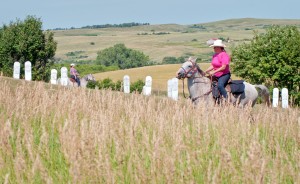This North Dakota county gives you nearly unlimited access to outdoor recreation — free!
You don’t need a boat to enjoy Lake Sakakawea. The magnificent lake is 180 miles long with 1,530 miles of PUBLIC shoreline.

Plenty of opportunities to wade in the water to cool off on a hot day hike.
As we found out, that means you can explore, hike, bike for days on end. Find a bay or inlet and you can camp next to the water, or if it’s a hot day, dive in and cool off. It’s what we did, and here’s all you need to know to enjoy the Lake.

Hiking the shoreline north of Charlson along Lake Sakakawea
First, a little background:
The Army Corps of Engineers created and maintains the lake; it owns the immediate shoreline. It says the lake covers 382,000 surface acres making it the largest manmade lake in North America where the entire shoreline is open to the public. It is world-famous for its recreation, walleye fishing and its paddlefish snagging.
History

Without a ferry system, McKenzie County farmers struggled to get grain to a nearby rail line across the Missouri River.
Lake Sakakawea was formed in the 1950’s by damming the Missouri River. Even before it was a lake, the River was a transportation barrier. The river challenged McKenzie County farmers to get their crops to market, going north across the river to Williston.
Ferries such as those at the ghost town Banks on the Tobacco Garden Creek helped farmers move their grain. Eventually, a bridge across the river at Williston helped ease transportation.
After WWII, the Army Corps of Engineers built a series of dams on the Missouri River, each one backing up on to historic tribal land and Indian Reservations. In 1956, the Garrison Dam swallowed up the largest amount of historic land in the new dam system.

Garrison Dam created Lake Sakakawea and flooded hundreds of thousands of farmland, and homes. Courtesy of State Historical Society of North Dakota (B8081).
The lake became a recreation attraction. It flooded some 150,000 acres, three towns, and several villages. It divided the Fort Berthold Indian Reservation so that two districts are south of the lake and three are north of the lake. Lake crossings are about 70-miles apart at the dam itself or at the Mountrail County/McKenzie County crossing, Four Bears Bridge.

Some of the towns and villages flooded by the creation of Lake Sakakawea.
What to do
If life before the dam intrigues you. The Three Affiliated Tribes Museum on the eastern edge of McKenzie County has a full display of pre-lake years. It’s that large A-Frame building inside a wrought-iron fence north of the Casino. We discovered you will need to check ahead to see if it is open. You can call 701-627-4477. Generally, it is said to be open from 10:00 a.m. to 4:00 p.m. That’s not always the case, though. The last two times we attempted to visit were during those hours, but it was closed.
Admission isn’t free but close. The last time we were there it was $3.00.
If you are successful, head to the second floor. That’s where we found the most interesting displays. It’s an eye-opener to learn the history of the Mandan, Hidatsa and Arikara nation. It will shape your views on the region.
If you are in to land-based activities, you’ve got hundreds of miles of opportunity. Many locations are easily accessed by following two-track trails or no-maintenance roads. The public access shoreline provides landlubbers the opportunity to hike and explore, swim, camp, view waterfowl and other birds. We like to drive north from Highway 23 on what is designated to be Highway 1806. It’s a good idea to be in a pickup truck, or a high-clearance vehicle to access the lake. Turn off 1806 to the north and explore the two-track trails. We’ve done it several times, but only when it’s dry enough that we won’t get stuck. The dog gets excited about this time because we slow down to about 5 mph and weave our way through the hills and valleys to the shoreline.
In the winter, when the lake’s many bays and inlets freeze over, cross-country skiing is possible. Snowmobilers often ride the ice and snow.

Pontoon and fishing boats are the most popular boats on the water. Up until about 1970, hydroplane boats raced on the lake, but floating trees and other debris made it too dangerous.
On the water, pleasure boats are commonly seen with passengers enjoying the vast expanse of water. In addition to swimming, water skiing, jet skiing, and scuba diving are just some of the favorite activities.
Fishermen travel from across the world to catch walleye, northern pike, and salmon. The waters also yield a good harvest of smallmouth bass, catfish, yellow perch, and trout.
For a few days in the spring, on the upper reaches of the lake, paddlefish snagging attracts thousands of people to the upper reaches of the lake on the northern edge of McKenzie County. The prehistoric fish lay on the bottom of the river where anglers snag them and harvest their eggs as caviar.
Click: The Williston Herald has a great story about paddlefish snagging.
How to get there:

East of Watford City on Hwy 23, you access Lake Sakakawea at Four Bears. The mile-long Four Bears Bridge spans the Missouri River and Lake Sakakawea
Drive north or east of Watford City in McKenzie County. State Highway 1806 north or State Highway 23 east will take you to the shores of Lake Sakakawea.
If you use Google Maps, you’ll get something like this (the complete round trip with an extension to Four Bears is almost 3 hours. But if you are just going to one spot, the drive is less than one hour):

Easy access from Watford City to Lake Sakakawea.
Our Recommendation
We were not boating when we explored the region. We went northeast of Watford City and then north past the ghost town of Charlson. We always take with us a U.S. Forest Service Map ($13) to see all the back roads and trails that got us down to the lake for a good day of hiking, sightseeing, and swimming. Another useful tool is Google Earth that gives you a precise location and a view of what’s ahead on the trail.

Imagine the steep valley that drops down below this tributary to Lake Sakakawea. You can hike along the top, or take a canoe to explore the shoreline.
If you own a kayak or canoe, just about any road that goes up to the lake from McKenzie County will give you access. Again, a U.S. Forest Service Map is most helpful to find those access roads.
We have accessed the waterscape on canoe. This summer we’ll do it with a kayak. It allowed us to get up in to some of the tributaries. Exploring the upper reaches scratches the curiosity itch.

A canoe or other smaller fishing boats gets up in to some of the tributaries of Lake Sakakawea so you can explore hidden riches.
If you want to get out on the water for little money (not free)– consider renting a canoe or kayak. You can follow the shoreline, investigate bays and inlets, and get a sense of what it must have been like for the Thomas Jefferson’s Corps of Discovery.
Admittedly, it’s hard to find a canoe or kayak to rent. Are there any in Williston or Minot? I don’t know any rentals. Do you?
East of Williston in Williams County (directly across the lake from Tobacco Gardens in McKenzie County) is Lund’s Landing. You can rent a kayak or canoe there for the day.
http://www.lundslanding.com/fishingboatrentals.htm
People who drive up from Bismarck have a couple of places where they can pick up a canoe or kayak in Mandan. They have multi-day rates so you can rent one day and return the next.
http://0317f38.netsolhost.com/rentals.html
http://www.paddleonnd.com/rentals.html#kayak
If you have a boat, here are a couple of good points to consider: the first access point is the Four Bears Peninsula, on the far eastern edge of McKenzie County, is a popular access to the water. A boat ramp, bait shop and large parking area will let you get out on the water. It will introduce you to Native American history of the region. Go in August to take in the Little Shell Powwow. The peninsula extends south of the Four Bears Casino where people camp, fish and picnic.
Others recommend
(The goal this summer is to check out this highly recommended McKenzie County location.)
The second access point is Tobacco Garden Creek Bay — 2 miles east of Watford City on ND Highway 23, then 25 miles north and east on ND Highway 1806. The resort is open year round and is pet-friendly. A full-service restaurant serving: Breakfast, Lunch, and Dinner – with Prime rib every Saturday Night. A convenience store providing Groceries, camping supplies, off sale beer, bait and tackle shop, gas on the water, and everything in between. There are over 100 camp sites, two log cabins, family picnic shelters, two playgrounds, wireless Internet and hiking on the Birnt Hills Trail – a certified Lewis and Clark site.
We’re always looking for other free or low-cost opportunities to explore Lake Sakakawea. What do you recommend?
Here’s another free spot in McKenzie County to explore
Subscribe to this blog to get more ideas to explore in this great state of North Dakota
To get a free 22 page travelogue to plan your trip in McKenzie County, just type in the word “McKenzie” in the subject field and send.


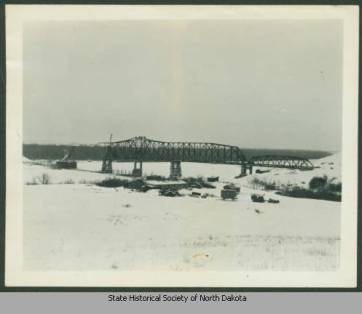





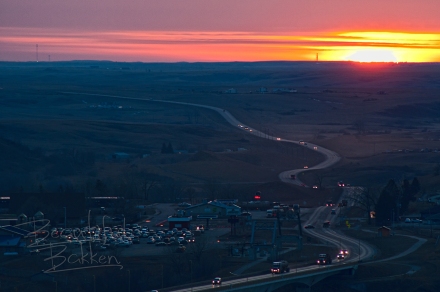












 As soon as you cross the Highway 200 bridge turn south in to the Sundheim public park on the west bank of the Yellowstone. Drive up the ramp to the parking area and take a hike. It’s safe, secure, handicap accessible and above all, you don’t have to worry about meeting a train like travelers worried about 30 years ago. Both the bridge and tunnel are closed to all traffic except pedestrians.
As soon as you cross the Highway 200 bridge turn south in to the Sundheim public park on the west bank of the Yellowstone. Drive up the ramp to the parking area and take a hike. It’s safe, secure, handicap accessible and above all, you don’t have to worry about meeting a train like travelers worried about 30 years ago. Both the bridge and tunnel are closed to all traffic except pedestrians.
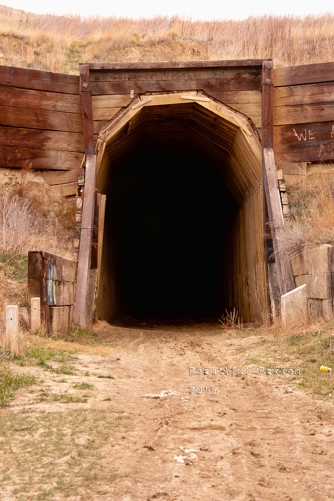


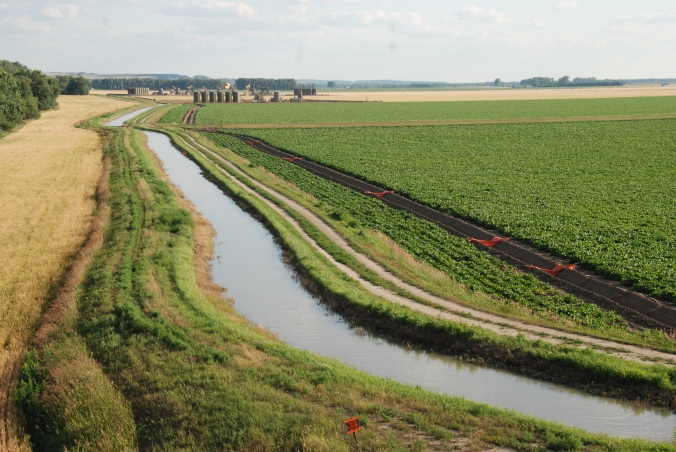
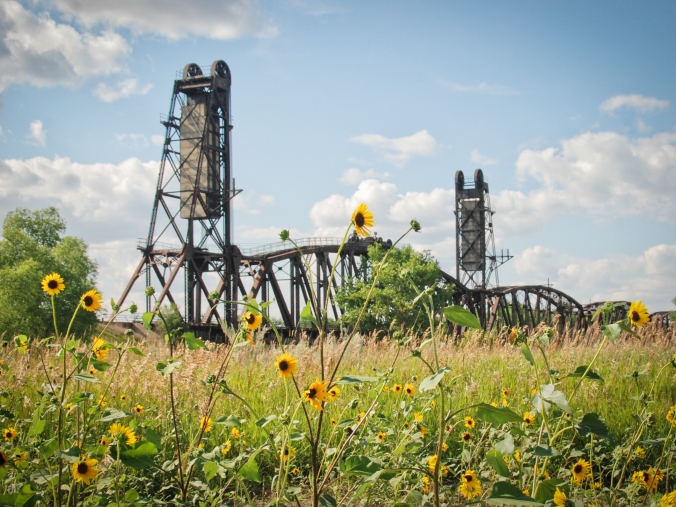


 Walk the 6-block long blacktop trail from the Confluence center down toward historic Fort Buford where an actual cemetery with
Walk the 6-block long blacktop trail from the Confluence center down toward historic Fort Buford where an actual cemetery with less-than-actual headstones inform you about how tough it was living here 150 years ago.
less-than-actual headstones inform you about how tough it was living here 150 years ago.

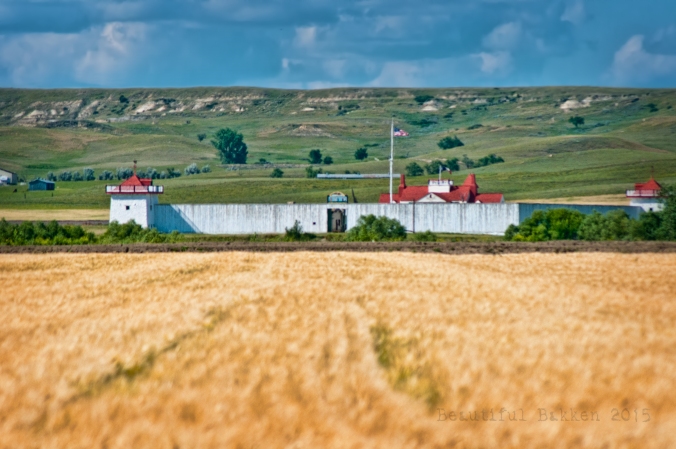


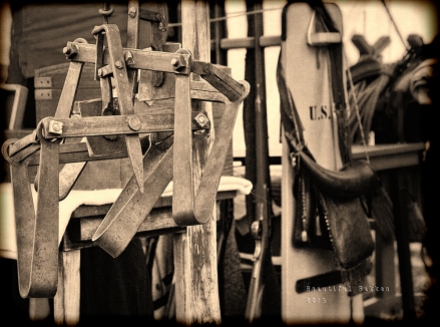

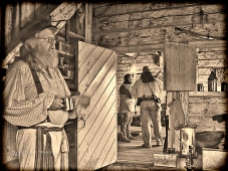












 The old-timer’s words were demonstrated; a gathering and multiple conversations were housed on the front porch of the Bourgeois House.
The old-timer’s words were demonstrated; a gathering and multiple conversations were housed on the front porch of the Bourgeois House.
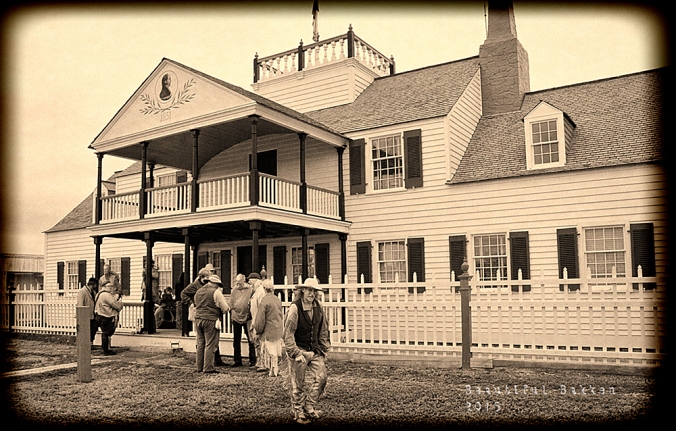

 His target, down by the river, was out of sight at the moment. By the time he got his shot ready, the target would be visible again. His efforts attracted the attention of friends and strange visitors. After a couple of misfires, his shot echoed across the valley.
His target, down by the river, was out of sight at the moment. By the time he got his shot ready, the target would be visible again. His efforts attracted the attention of friends and strange visitors. After a couple of misfires, his shot echoed across the valley.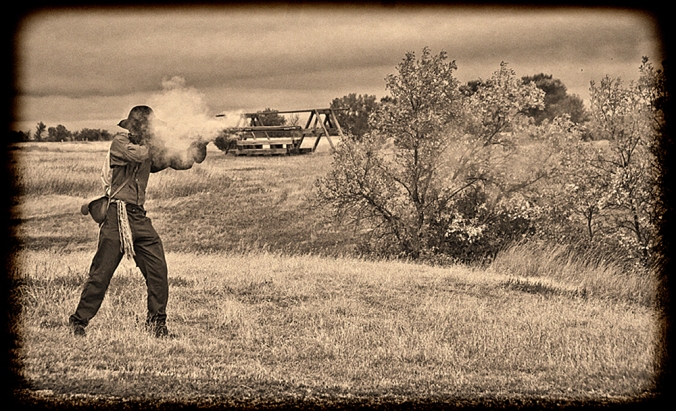
 A few spectators watched as the shooter demonstrated his skills. Some, chose to stay inside, including a small gathering of men who sat and swapped stories.
A few spectators watched as the shooter demonstrated his skills. Some, chose to stay inside, including a small gathering of men who sat and swapped stories. The visitors who had come so far to visit the Fort Union Trading Post were warmly received and learned much from this annual gathering.
The visitors who had come so far to visit the Fort Union Trading Post were warmly received and learned much from this annual gathering.  The visit extended until nearly sunset when the gathering broke up and headed to their lodging for the evening, some outside the post, and some farther down the river in more civilized settlements. There, they spread the word of the days’ events on
The visit extended until nearly sunset when the gathering broke up and headed to their lodging for the evening, some outside the post, and some farther down the river in more civilized settlements. There, they spread the word of the days’ events on 







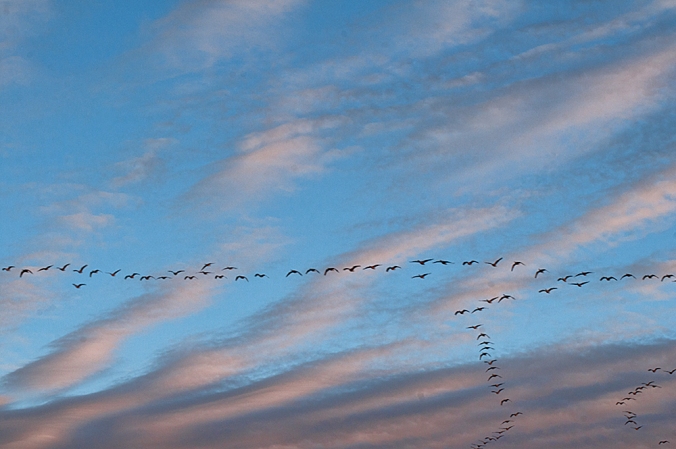
 The environment picks up that warm golden glow. Across the river the sun drops behind Oliver and Mercer Counties.
The environment picks up that warm golden glow. Across the river the sun drops behind Oliver and Mercer Counties.








